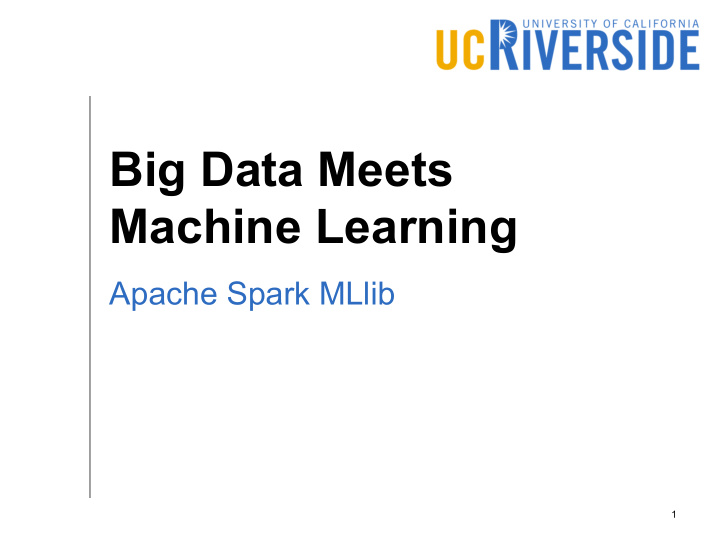



Big Data Meets Machine Learning Apache Spark MLlib 1
MLlib Spark MLlib Graphx … Streaming Spark Dataframe Spark Core (RDD) 2
Machine Learning Algorithms Supervised learning Given a set of features and labels Builds a model that predicts the label from the features E.g., classification and regression Unsupervised learning Given a set of features without labels Finds interesting patterns or underlying structure E.g., clustering and association mining 3
Overview of MLlib Simple primitives Basic Statistics Extractors, transformations Estimators Evaluators Model tuning 4
spark.mllib Vs spark.ml spark.mllib RDD-based library which is now in maintenance mode Will be deprecated in Spark 3.x Not recommended to use spark.ml Dataframe-based API Recommended Replaces (almost) everything in the RDD-API Be aware when searching online on which API is used 5
Simple Primitives Local Vector (Data Type) To represent features Example: (1.2, 0.0, 0.0, 3.4) Dense vector [1.2, 0.0, 0.0, 3.4] Sparse vector [0, 3], [1.2, 3.4] Local Matrix (Data Type) Dense and Sparse Dataframe.randomSplit Randomly splits an input dataset Helps in building training and test sets 6
Basic Statistics Column statistics Minimum, Maximum, count, … etc. Correlation Pearson’s and Spearman’s correlation Hypothesis testing Chi-square Test 𝜓 ! 7
ML Stages Data Data Input Loading Cleaning Feature Model Model Estimator extraction and Model Model transformation Parameters Evaluator Test data Final Prediction Model 8
ML Pipeline Parameters Feature Feature Feature extraction and Feature Input extraction and extraction and transformation extraction and Estimator transformation transformation transformation Final Pipeline Model Best Parameter Validator Grid Model Evaluator 9
Transformations Used in feature extraction, dimensionality reduction, or schema transformation Text transformations Encoding Normalization Hashing 10
TF-IDF Term Frequency-Inverse Document Frequency A measure of the importance of a term in a document TF: Count of a term in a document DF: Number of documents that contain a term ! "# 𝐽𝐸𝐺 𝑢, 𝐸 = log !$ %,! "# 𝑈𝐺𝐽𝐸𝐺 𝑢, 𝐸 = 𝑈𝐺 𝑢, 𝑒 ⋅ 𝐽𝐸𝐺(𝑢, 𝐸) Classes: HashingTF, CountVectorizer 11
Word2Vec Converts each sequence of words to a fixed- size vector Similar sequences of words are supposed to be mapped to nearby vectors using this model 12
Other Text Transformers Tokenizer: Extracts words (tokens) from text StopWordRemover: Removes common words, e.g., a, the, an n -gram: Given a sequence of words, it generates subsequences of length n StringIndexer: Converts each unique string, e.g., label or class, to a numeric value IndexToString: Converts each integer value to a String value using a lookup table 13
Encoders PCA (Principal Component Analysis) Reduces number of dimensions to a set of uncorrelated dimensions (components) DiscreteCosineTransform (DCT) Frequency analysis OneHotEncoder: Converts categorical values to a vector with one bit set for the category 14
Numeric Transformers Binarizer: Converts numerical values to (0/1) based on a threshold Bucketizer: Converts continuous values to a set of n+1 buckets based on n thresholds QuantileDiscretizer: Places numeric values into buckets based on quantiles Normalizer: normalizes each vector to have unit norm. For example, 2.0 → 0.25 4.0 10.0 0.625 0.125 MinMaxScaler: Scales each feature in a vector to a standard scale, e.g., [0.0, 1.0] 15
Other Transformers Imputer: Replaces missing values by a number or the mean VectorAssembler: Combines multiple attributes into a vector attribute VectorSlicer: Extracts a subarray of a long vector SQLTransformer: Applies an SQL query on the input dataset 16
Applying Transformers Simple transformers Can be applied by looking at each individual record E.g., Bucketizer , or VectorAssembler Applied by calling the transform method E.g., outdf = model.transform(indf) Holistic transformers Need to see the entire dataset first before they can work e.g., MinMaxScaler , HashingTF , StringIndexer To apply them, you need to call fit then transform e.g., outdf = model.fit(indf).transform(indf) 17
Estimators An estimator is a machine learning algorithm that fits a model on the data Classification Classifies data points into discrete points (categories) Regression Estimates a continuous numeric Clustering Groups similar records together into clusters Collaborative filtering (Recommendation) Predicts (missing) user ratings for items Frequent Pattern Mining 18
Classification and regression Supervised learning algorithms Classification Logistic regression Decision tree Naïve Bayes … Regression Linear regression Decision tree regression Random forest regression … 19
Clustering Unsupervised learning method K-means clustering. Clustering based on distance between vectors Latent Dirichlet allocation (LDA). Groups vectors based on some latent (hidden) variables Bisecting k-means. Hierarchical clustering Gaussian Mixture Model (GMM). Breaks down data distribution into multiple Gaussian distributions 20
Evaluators An Evaluator takes a model and produces numeric values that measure the goodness of the model for a specific dataset BinaryClassificationEvaluator evaluates binary classifiers using precision, recall, F- measure, area under ROC curve, … etc. MulticlassClassificationEvaluator evaluates multiclass classifiers using confusion matrix, accuracy, precision, recall … etc. 21
Evaluators ClusteringEvaluator evaluates clustering algorithms using sum of squared distances RegressionEvaluator evaluates regression models using Mean Squared Error (MSE), Root Mean Squared Error (RMSE) … etc. 22
Validators Each model has its own parameters that are usually no intuitive to tune A validator takes a pipeline, an evaluator, and a set of parameters and it tries all possible combinations of parameters to find the best model, i.e., the model that gives the best numeric evaluation metric Examples, CrossValidator and TrainValidationSplit 23
Further Reading Documentation http://spark.apache.org/docs/latest/ml-guide.html MLlib paper X. Meng et al, “MLlib: Machine Learning in Apache Spark”, Journal of Machine Learning Research 17:34:1-34:7 (2016) 24
Recommend
More recommend